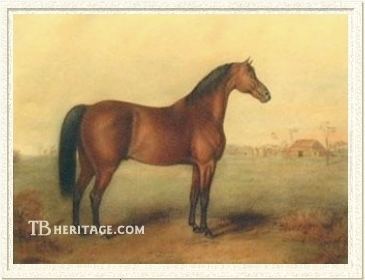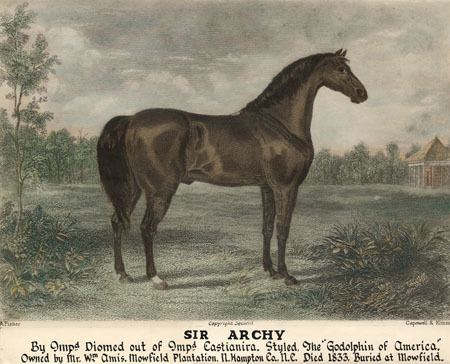Dam Castianira GB Foaled 1805 Species Equus caballus | Died 7 June 1833 Parents Diomed Children Lady Lightfoot, Timoleon | |
 | ||
Country | ||
U belong to me by sir archy
Sir Archy (or Archy, Archie, or Sir Archie; 1805–1833) was an American Thoroughbred racehorse considered one of the best racehorses of his time and later an important sire.
Contents
- U belong to me by sir archy
- Early life
- On the track
- At stud
- Sir Archys progeny
- As sire
- As grandsire and beyond
- Retirement
- Pedigree
- References

Early life

Born and bred in Virginia by two Americans, Capt. Archibald Randolph and Col. John Tayloe III, Sir Archy's sire was the inaugural Epsom Derby winner Diomed, who had been imported from England as an older horse. His dam, a blind mare named Castianira, had been purchased in England by Tayloe for his own Mount Airy Farm, but was bred on shares with his friend Randolph. Sir Archy, Castianira's second foal, was born on Randolph's Ben Lomond Plantation on the James River in Goochland County. The colt, dark bay with a small patch of white on his right hind pastern, was originally named "Robert Burns"; Tayloe changed the colt's name in honor of Randolph.
On the track
When Sir Archy was two, Tayloe and Randolph sold him to Ralph Wormely IV for $400 and an unknown filly. When Wormely later decided to quit horse racing Sir Archy was offered for sale, but there were no takers. Still owned by Wormely, Sir Archy made his first start in the Washington (D.C.) Sweepstakes late in his three-year-old season. At this point, he already stood 16 hands (64 inches, 163 cm) high. Though Sir Archy had not yet recovered from a case of strangles, Wormely ran him rather than pay a forfeit fee. Still unwell, Sir Archy made his second start a month later at the Fairfield Sweepstakes in Richmond, Virginia. Though he won only the third heat and finished third overall to Col. William Ransom Johnson's colt True Blue, Johnson promptly bought Sir Archy for $1,500.
Now in the hands of Johnson's trainer, Arthur Taylor, Sir Archy became one of the greatest runners of his day, excelling in four-mile heats. Johnson wrote, "I have only to say that, in my opinion, Sir Archy is the best horse I ever saw, and I well know that I never had any thing to do with one that was at all his equal; and this I will back; for, if any horse in the world, will run against him at any half way ground, four mile heats, according to the rules of racing, you may consider me $5000 with you on him. He was in good condition this fall, (1809) and has not run with any horse that could put him to half speed towards the end of the race."
One of his most important matches was with Blank, in which Sir Arch won the first heat in 7:53 – the fastest time ever run to that point south of the James River. Following that race, he was purchased for $5,000 by General William Richardson Davie, the governor of North Carolina. Davie retired the horse to stud because there were no opponents willing to race against him. His record on the racetrack was 7 starts, with 4 wins and 1 second.
At stud
Sir Archy then became what most experts consider to be the first great Thoroughbred stallion bred in America. He went to stud, at first under Davie, then under Davie's son, who appears to have stood the stallion in Virginia for a couple of years. Then William Amis bought Sir Archy, and stood the horse for 17 years at his plantation, Mowfield, near the Roanoke River in Northampton County, North Carolina. Even at the advanced age of 24, Sir Archy's stud fee was $100. Amis' son estimated that during the years he stood at Mowfield, Sir Archy earned $76,000 in stud fees.
The stallion became known as the Godolphin Arabian of America, meaning that his influence on the American Thoroughbred was as important as the Godolphin Arabian's influence on European breeding. Like the "Blind Hero of Woodburn", Lexington — who was his great–grandson — Sir Archy became one of America's greatest foundation sires. Throughout the 1820s, the fastest horses in America were descendants of Sir Archy.
In 1827, the Washington DC Jockey Club and the Maryland Jockey Club announced that only a limited number of horses were eligible to run in their races. Although the fine points of the announcement were complex, it effectively barred all horses sired by Sir Archy; his offspring were so successful that few, if any, horses not sired by Sir Archy bothered to race. Both Jockey Clubs admitted they were concerned about their long-term viability.
Sir Archy's progeny
Turf historian John Hervey wrote: "Before nor since, nothing has been known in America to equal the manner in which the Archys dominated both turf and stud for over half a century, beginning with the debut of his first crop of foals, in 1814 and culminating with the last of the sixteen seasons of premiership of his inbred great-grandson Lexington in 1878."
As sire
Siring at least 31 racing champions, and influencing the American Quarter Horse through his son Copperbottom, the following is a list of some of his most notable offspring:
As grandsire and beyond
Into the second generation, Sir Archy's influence became even more pronounced. This was partly because inbreeding to Sir Archy and to his sire, Diomed, became quite fashionable among American breeders. In Sir Archy's case, he was bred back to his daughters and his sire's daughters. This kind of inbreeding, ordinarily risky, was successful for the Sir Archy-Diomed line.
Retirement
At the age of 26 Sir Archy ended his stud career in 1831, living for two more years until his death in 1833 on June 7. Coincidentally, this was the same day that one of his greatest sons (Sir Charles) also died.
Sir Archy was one of the first few horses inducted into the National Museum of Racing and Hall of Fame in 1955.
Sir Archy's burial location is disputed between two locations:
Pedigree
Sir Archy is inbred 3s x 4d to Herod, meaning Herod appears in the third generation of the sire's side of the pedigree and in the fourth generation of the dam's side.
